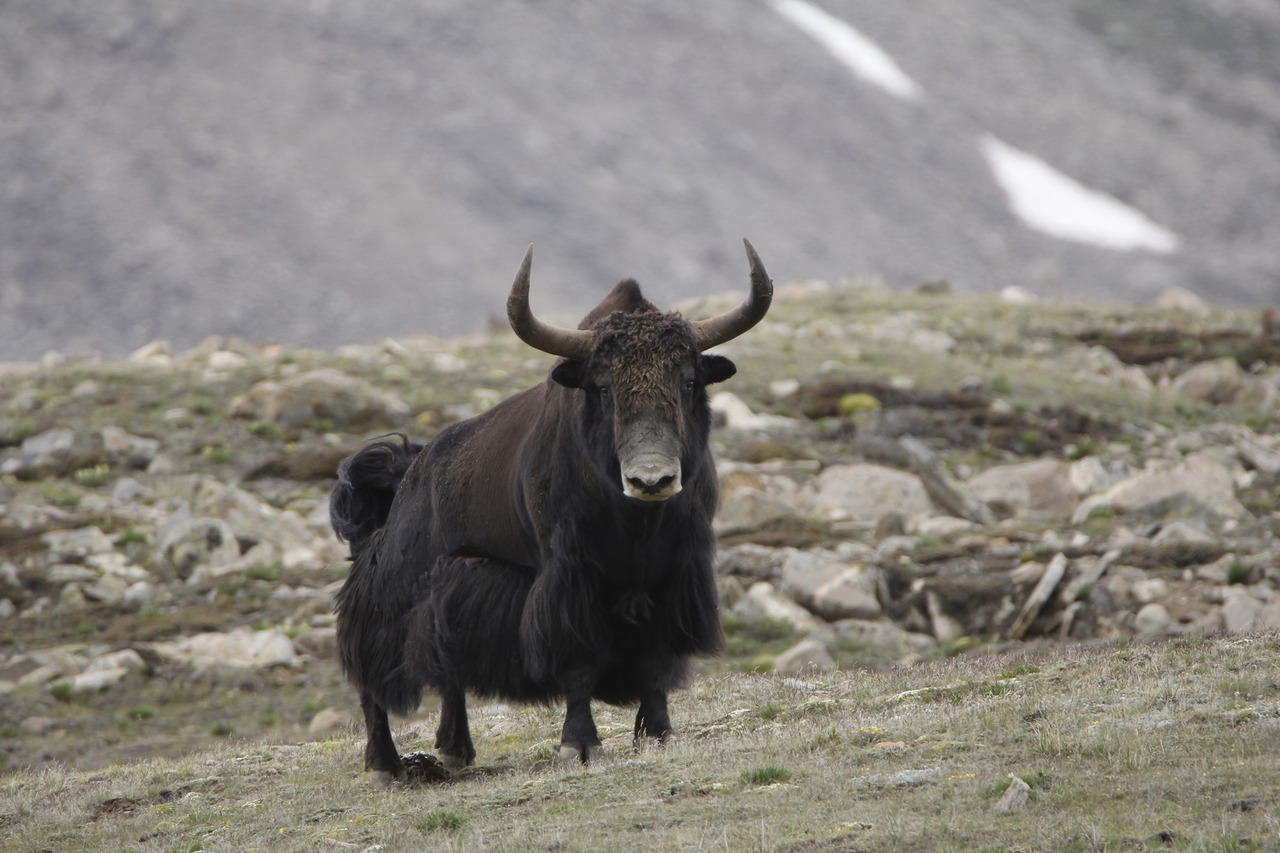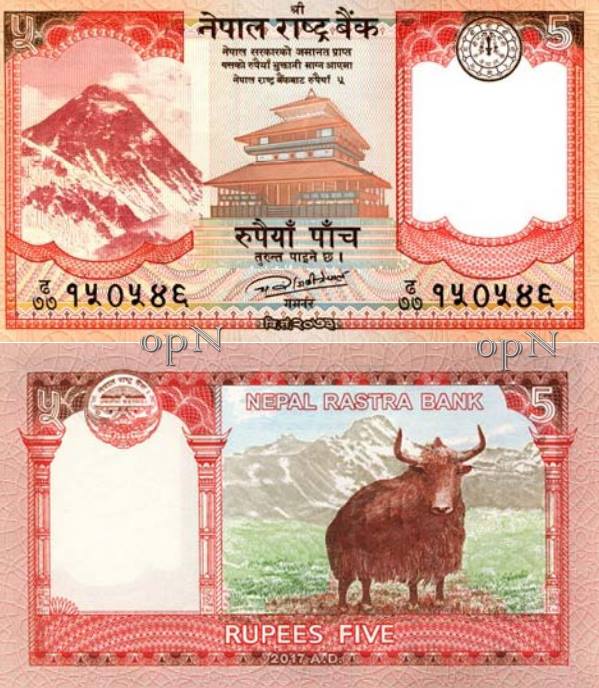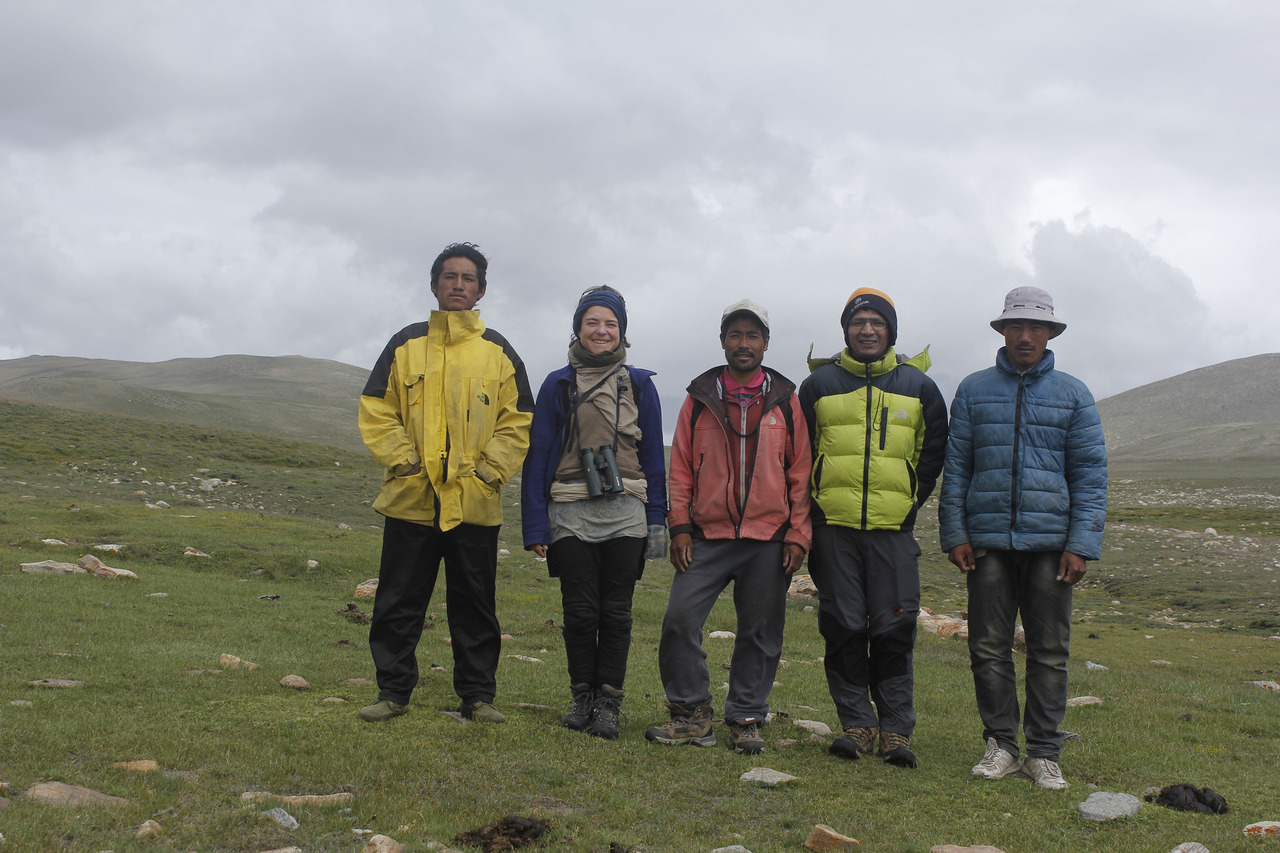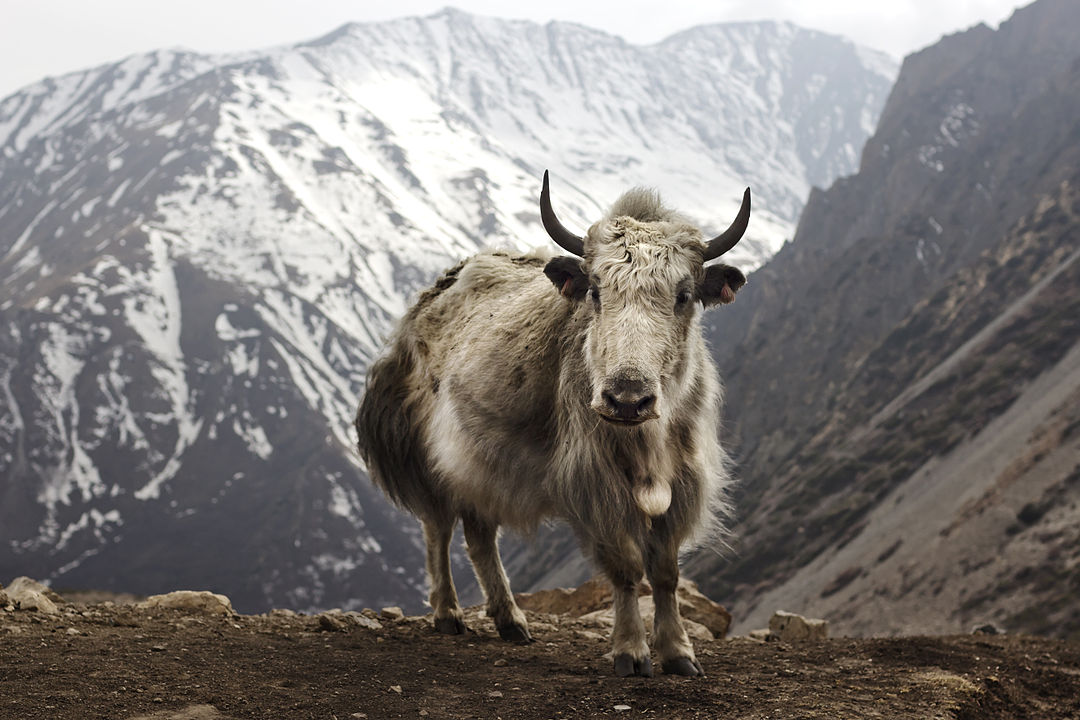- In July, researchers Naresh Kusi and Geraldine Werhahn spotted three wild yaks in Nepal, where sightings are rare and the animal was once thought to have gone extinct.
- Kusi spoke with Mongabay about the significance of the sightings of this iconic bovine’s distribution in the region and the need for conservation.
- Wild yaks (Bos mutus) are considered the ancestor of the domesticated yak (Bos grunniens) and hold an important place in the region’s culture and history.
KATHMANDU – Wild yaks (Bos mutus) are believed to have once roamed the regions north of Nepal’s Himalayas. The iconic large bovine, considered the ancestor of the domesticated yak (Bos grunniens), is native to the mountains and had a deep relationship with the people living north of the tallest mountains in the world.
However, even the sighting of the animal, now categorized as “vulnerable” by IUCN, the global conservation authority, has been rare in Nepal since the dawn of the new millennium — although they are still found in numbers in neighboring Tibet. As the red list says that its presence in Nepal is uncertain, researchers and wildlife photographers alike feel excited to catch a glimpse of them.
Researcher Naresh Kusi is no exception. He, along with researcher Geraldine Werhahn, were thrilled to encounter three wild yaks (known as dong in Tibetan) in Humla district of Nepal in July this year. This was a sight to behold for the duo, who were the first to sight the animal in 2014, decades after they were believed to have gone extinct. Following their discoveries, the IUCN plans to conduct a reassessment of the distribution map of the animal to possibly include Nepal.
Kusi, now country program director at the Himalayan Wolves Project, has relentlessly studied wild yaks since 2014. Mongabay’s Abhaya Raj Joshi met Kusi in Kathmandu recently to talk about the status of the species in Nepal, its cultural significance and what’s needed to conserve it.
Mongabay: Let’s start with the photo of the three wild yaks you took earlier this year. Could you tell us about it?
Naresh Kusi: Yes, the sighting was quite interesting. When we showed the photo to experts such as Professor Joel Berger and George Schaller, some of them suggested that of the three animals in the photo, one was a female with her young male calf and the other one an older, bigger male.
The possible presence of the female yak was very exciting for us, as it is an indication that the yaks are reproducing in Nepal, and were not just in Nepal as seasonal migrants.
However, veteran Nepali conservationist Karan Shah said that as the trio look similar in physical gait and body size and have thick sweeping horns, all of them could be males of different age groups. He said that if we have males in the area, there is an equal possibility of the presence of females.
Mongabay: How does your photo add up to the existing knowledge of the status of the animal in Nepal?
Naresh Kusi: In the early 2000s, the IUCN assessment of the species stated that the animal may have gone locally extinct in Nepal. We fortunately spotted it in Nepal in 2014 and I co-authored a study in the journal Mammalia in 2015. However, questions were raised as to whether the yak was really a wild yak, as people in the Himalayas tend to leave their male yaks to roam freely, except during winter. There’s also a practice of offering male yaks to the gods and setting them free.

We had to present genetic evidence to show that the yak was really a wild one.
So between 2015-18 I led a research and conservation project on wild yaks in Nepal to assess its status and to provide much-needed genetic verification. In 2017, the government of Nepal recognized the work we did and released a new 5 rupee note containing the photo of the wild yak taken by our team in 2015.

During the course of the project, we also managed to collect DNA samples of the animal. We published results from the study in 2021, revealing that the wild yaks in Upper Humla, Nepal, are genetically similar to the wild yaks found in Qinghai-Tibetan Plateau in neighboring China.
Mongabay: Has the development caught the attention of the IUCN yet?
Naresh Kusi: The IUCN Wild Cattle Specialist Group has informed us that they will conduct a red list assessment update for the wild yak between 2021-24. We hope that this will help reestablish the wild yaks in Nepal in the global range map.
Mongabay: What’s the difference between wild and domestic yaks? Why is saving wild yaks important?
It’s like the case of dogs and wolves. They were domesticated a long time ago and they developed as a separate species. Similar is the case with yaks, some of which were domesticated in the Holocene.
The wild yak is around 1.5 times bigger than the domestic yak and belongs to a different species altogether. There are millions of domestic yaks in different countries in the Himalayas, but the wild yaks are limited to a few thousand.
As conservationists, we want to conserve the wild yak, as they have a different genetic pool compared to the domestic ones.
There’s a myth among some communities that cross-breeding wild yaks with domestic yaks would produce offspring that would produce more milk. However, they have now realized that domestic female yaks go through excruciating labor pain if they have mated with a wild yak. Also, the chances of a miscarriage are pretty high. This doesn’t make sense, as female yaks cost more than Rs150,000 ($1,555). So herders try to ward off wild hormonally charged male yaks whenever they see them.
They even castrate the domesticated male yaks to tame their aggression.
Mongabay: It is said that the yaks had an important role to play in the people’s lives for a long time. What did the people say during your interactions with them?
Wild yaks have always had a special place in Tibetan culture. During weddings, hair from wild yaks is used to make arrows that have a special significance in the ceremony. Also, whenever sources of water dried up, the people offered strands of yak hair to the gods to appease them and fill the springs with water again.
The other interesting practice is related to “reverse altitude sickness.” We’ve seen that whenever people from the lowlands head to the mountains, they get altitude sickness. But similar is true for people living in the highlands when they come to lower altitudes. So the Tibetan people would carry tablets made of blood from the yak’s heart to treat symptoms they got while traveling to lowlands. Wild yak hair is also used to make tents.

Mongabay: Such wide-ranging utility of the animal suggests that they might have been very abundant in the area in the past.
Naresh Kusi: Yes, it’s quite possible.
Mongabay: What could be the possible reasons for their decline?
Naresh Kusi: I think the main reason is wide-scale killing and hunting. We’ve heard that a wild yak’s head was considered as a symbol of prestige and people used to hang it on the door of their houses.
Wild yaks also meant free meat. Free-ranging yaks’ meat is believed to be more delicious than that of the domesticated ones. One yak can produce around a quintal of meat that can feed a family for weeks.
As I said earlier, people don’t want male wild yaks to mate with their domesticated female yaks. So whenever the wild male yaks come near the domesticated female yaks, farmers retaliate, and that could lead to [the yaks’] death.
Mongabay: But don’t the increased sightings of wild yaks suggest that their population is increasing in Nepal?
Naresh Kusi: I think it was during the last five to six years that the situation has become favorable for the yaks to return to Nepal. It was partially due to the COVID-19 pandemic, which pushed people to stay in their homes. Similarly, people’s livelihoods have changed and local governments are doing their bit by protecting pasture land where yaks graze. In July, we spotted three wild yaks, but people have told us they have seen up to six.
Mongabay: The Limi Valley in Humla where the yaks were found is considered the last refuge of wild yaks in Nepal. Is there a possibility that wild yaks may be present in other parts of the country?
Naresh Kusi: We have reasons to believe that they may have developed a population in an area in Mustang, where people have not set foot on for the last three decades. When people set foot on the Ghamilek around three decades ago, there was a snowstorm followed by a drought. People linked this event to the wrath of god and banned the movement of people in the area. As it provides conducive habitat for yaks, they might have already come there from across the border.

Mongabay: What do you think needs to be done to protect yaks in Nepal? Is it possible to reintroduce them by bringing some yaks from Tibet?
Naresh Kusi: If we ensure that the habitat is conducive for yaks, they will automatically come from Tibet, breed here and stay in Nepal. That’s a better approach to conservation than reintroduction. We’ve seen that in the case of the Himalayan wolves that have already made a comeback in the past few years.
Mongabay: How about the impact of climate change?
Naresh Kusi : Yes, climate change is a big threat to overall biodiversity. However, in the case of yaks, there are other factors that pose more immediate threats. For example, poaching, pollution and habitat fragmentation are more important issues that need to be addressed.
Mongabay: In terms of research, what should be the next step?
Naresh Kusi: At the moment, we need more conservation than research. Having said that, we need to focus on disease dynamics, hybridization of the existing wild population. For example, are wild yaks being affected by disease? Is the disease being transmitted to or from domestic animals?
We hope that the reassessment of the distribution of wild yaks based on our research will add Nepal to its distribution range. This will garner more attention to the species and its conservation.
Banner Image: Three wild yaks sighted in Sakya khola Valley of Upper Humla in July 2022. Image by Naresh Kusi
Feedback: Use this form to send a message to the author of this post. If you want to post a public comment, you can do that at the bottom of the page
It’s no Yeti, but Tibetan brown bear’s presence in Nepal is no longer a myth
This story first appeared on Mongabay
South Africa Today – Environment
This article is licensed under a Creative Commons Attribution-NoDerivatives 4.0 International License.
You may republish this article, so long as you credit the authors and Mongabay, and do not change the text. Please include a link back to the original article.












